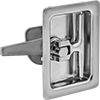Filter by
Mount Type
Latching Distance
Opens With
Cam Latch Type
For Use On
Through-Hole Diameter
Finish
Mounting Location
Latch Turn Direction
Mounting Screw Size
Overall Length
Latching Distance Adjustability
Export Control Classification Number (ECCN)
DFARS Specialty Metals
Strike Plate Material
Draw Latch Type
Environment
Building and Machinery Hardware
Fabricating and Machining







































